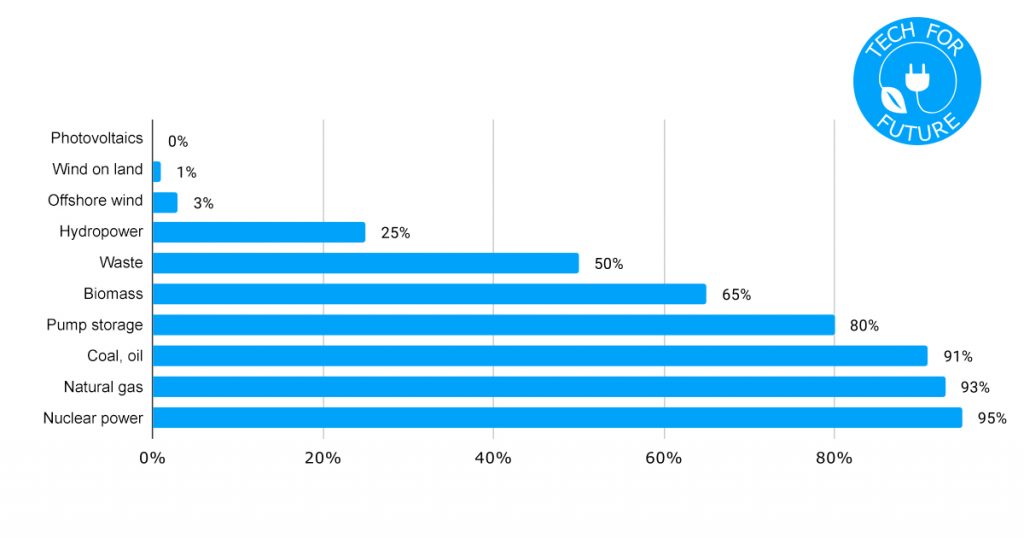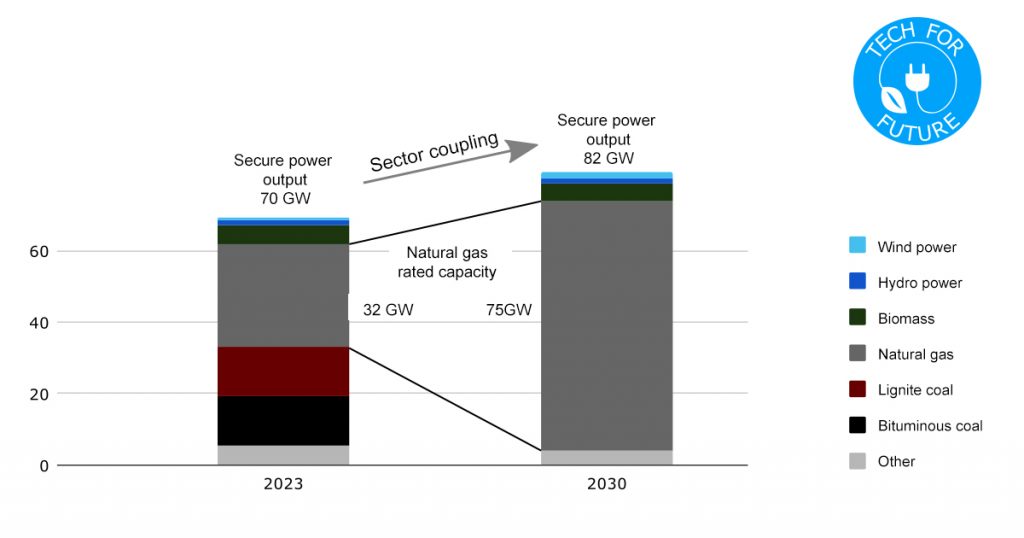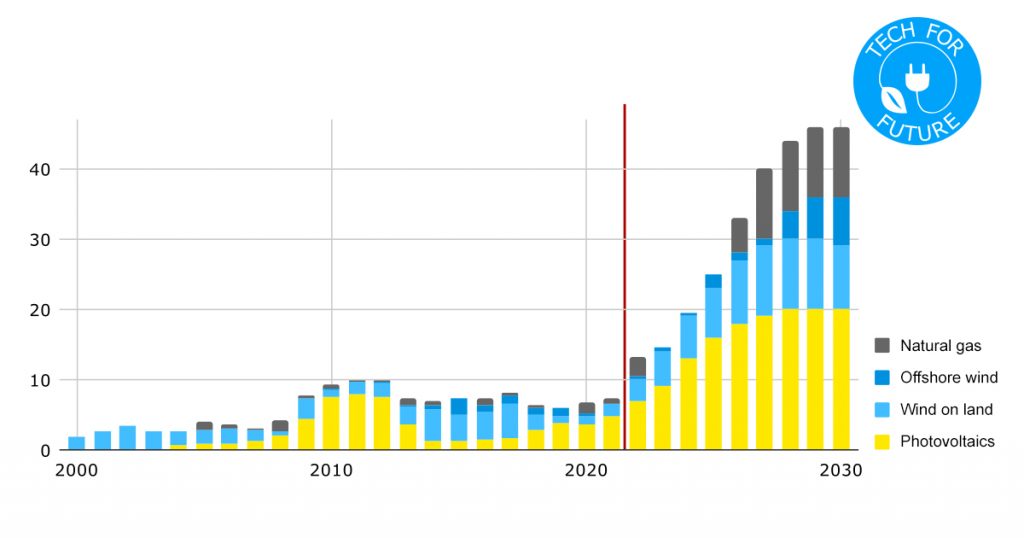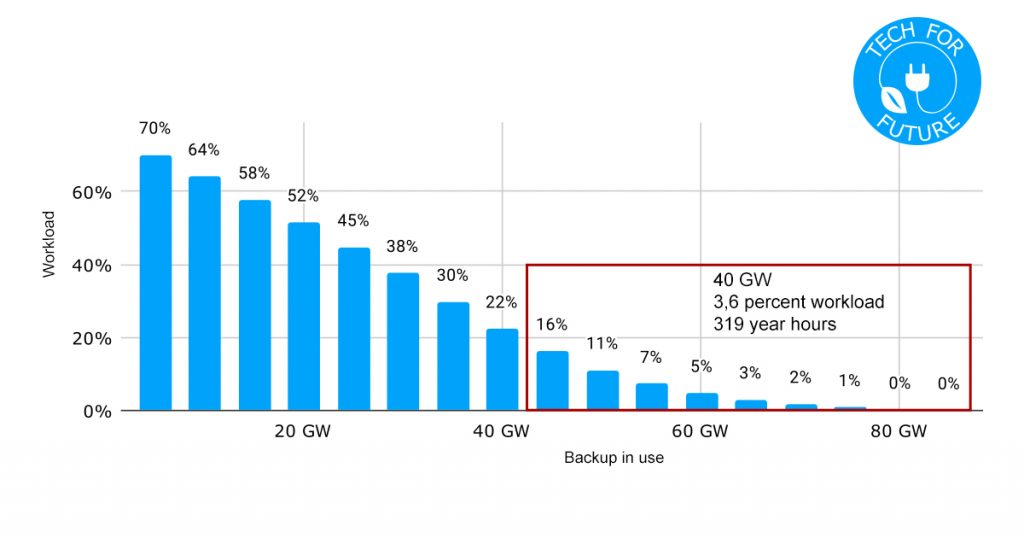_ Florian Blümm, graduated computer scientist, Tech for Future. Berlin, 9 February 2022.*
The German coal phase-out has been decided by official Berlin. But is the end of coal-fired power generation in Germany really possible by 2038 or even 2030? And does it make sense?
Executive summary
Of the major energy sources, coal causes the worst damage to the climate, environment and health. The planned German phase-out of coal by 2038 is therefore commendable, and even more so the accelerated phase-out of coal by 2030.
But we shouldn’t throw the baby out with the bath water. Domestic coal-fired power plants can still be important in overcoming power supply bottlenecks. Instead of switching off coal-fired power plants, we should burn significantly less coal as soon as possible. A 99 percent coal exit is better than a 100 percent exit The climate doesn’t care when the country shuts down coal-fired power plants, whether it’s today or in 2050. It depends on how much coal is burned. Germany will have no choice but to continue operating the coal-fired power plants. The country builds far too few gas power plants.
Coal phase-out in Germany by 2030: What is the problem?
Fig. 1. Assured power of energy sources (2018, in percent)
Performance credit subject to availability in Germany

Source: Network Transparency (2018).
We can’t switch off without switching on first. The guaranteed output from coal-fired power plants must be replaced by the addition of gas-fired power plants.
Solar power and wind power contribute almost no guaranteed output. The sun doesn’t shine at night and due to lulls in the wind happen frequently.
Even a tenfold increase in wind and solar power generation will not enable a coal phase-out. 100 GW of wind power can only replace a 1 GW coal-fired power plant. 100 GW of solar cannot replace anything.
So the late phase-out of coal is not due to the sluggish expansion of renewables. We could shut down all coal plants immediately if we had enough gas plants or nuclear plants.
In fact, Germany could have phased out coal years ago instead of nuclear. But despite the climate crisis and the energy crisis, the country is going through with the nuclear phase-out.
Is it even possible to phase out coal by 2030, as desired by the Greens, SPD and FDP? And does a coal exit even make sense?
Phasing out coal means entering natural gas: How many gas-fired power plants does Germany need?
Fig. 2. Secured capacity before and after coal phase-out (2023 and 2030)
Performance credits on the electricity market in GW according to the RES expansion plans of the traffic light coalition.

Source: Federal Network Agency (2021), coalition agreement of the traffic light coalition (2021), Network Transparency (2018).
The phasing out of coal combustion by 2030, ideally, is one of the goals of the traffic light coalition. However, before one can shut down coal-fired power plants, one has to replace guaranteed output with other controllable power plants.
The only realistic substitute for coal-fired power plants are fossil-fired natural gas power plants. By 2030 the nation will need between 70 GW and 80 GW of secured capacity from gas-fired power plants in order to be able to completely replace coal-fired power plants. This is how high the maximum residual load is expected in 2030 minus flexible loads.
Today Germany has 31.5 GW installed capacity gas power plants including reserve. A further 3.5 GW of gas power plants are currently under construction. By 2030, around 6 GW of gas power plants will be shut down due to age.
There is therefore a gap of between 40 GW and 50 GW of electrical output from gas-fired power plants by 2030 for a complete phase-out of coal. In addition, a good 15 GW of thermal district heating by means of combined heat and power generation will have to be managed by gas-fired power plants in the future. This corresponds to a further 5 GW of electricity. The largest gas power blocks have around 0.5 GW of electrical output. So, Germany would need at least 100 new power plant blocks by 2030, even if most of these blocks are huge.
Fact Check: Is it realistic to add 100 gas-fired power plants?
Fig. 3. Expansion target EEG amendment 2022 of the traffic light coalition (2000-2021 actual expansion, from 2022 planned expansion, in GWel peak output)

Source: Eröffnungsbilanz Klimaschutz BMWI (2022).
In the case of new gas-fired power plants, a pure construction period of 4 to 7 years is expected. In addition, there is planning and project planning, whereby the gas-fired power plants could largely be built at the sites of coal-fired power plants that are to be shut down. Even if one assumes accelerated planning, all 100 gas-fired power plants would have to be built in parallel.
That would be by far the most massive power plant expansion that has ever been attempted anywhere in the world in such a short time. Are there enough specialized companies to maintain 100 large construction sites at the same time? Where will the skilled workers come from and where will the 100 gas turbines come from?
The addition of 100 gas-fired power plant units by 2030 seems extremely unrealistic. Even the addition of around 30 GW of natural gas by 2030 for the previously planned slow phase-out of coal by 2038 will no longer be possible. That would still be 60 of the largest gas power plant blocks.
For every gas-fired power plant that is not completed on time, one fewer coal-fired power plant will be shut down. If security of supply is at risk, the Federal Network Agency gives its veto. For example, the Heyden 4 coal-fired power plant was already classified as systemically important in the first tendering round for the phase-out of coal and transferred to the reserve.
Utilization: How often are backup power plants needed?
Fig. 4. Utilization of German backup power plants (in 2030, in percent and GW)
Utilization for the expansion plans of the traffic light coalition in 2030 with weather data from 2015 to 2021.

Source: Science Media Center (2021), coalition agreement of the traffic light coalition (2021).
The above is a graph of the expected utilization in 2030 for backup power plants with weather data from 2015 to 2021. It is assumed that the expansion goals of the coalition in the EEG amendment 2022 will be achieved and the projected electricity consumption of 700 TWh per year as well.
- 70 percent utilization of the 5 GW most used backup capacity;
- 0.05 percent utilization on the 5 GW least used backup capacity.
The least used 5 GW power plant capacity is used on average for only 4 hours per year. Of the 6 years under review, they are actually only used in one year. The weather data from January 24, 2017 result in a 24-hour extreme situation within a longer period of dark doldrums. They stand still for the remaining 5 years.
It is almost irrelevant for the climate whether these 4 annual hours are now covered by 5 GW coal-fired power plants or natural gas power plants. If one has to build 5 GW of new natural gas power plants today, that is also harmful to the climate. The conversion to wood combustion planned for some coal-fired power plants would be even more harmful to the climate.
The least used 15 GW power plant capacity is used every year, but only 34 annual hours on average. According to the coal phase-out law, 15 GW of coal-fired power plants should still be connected to the grid by 2030. If they all end up in the safety reserve, that would be no worse for the climate than building new 15 GW gas-fired power plants.
Assuming that all 40 GW of coal-fired power plants that are still connected to the grid today would be transferred to the safety reserve. They would run an average of 319 hours per year, i.e. with a utilization rate of 3.6 percent. They would only have to produce 1.6 TWh of electricity per year, i.e. 0.2 percent of the annual electricity consumption. For comparison: in 2021, 162 TWh of electricity still came from coal with around 60 percent utilization of lignite-fired power plants and around 30 percent utilization of hard coal-fired power plants. So Germany would get out of coal a good 99 percent of the time.
Backup CO2: How harmful to the climate is a failure to phase out coal?
Coal is the dirtiest fuel. Air pollution kills more than 10,000 people every day, many of them from burning coal. Coal also has the highest greenhouse gas emissions.
But even natural gas still emits half as many greenhouse gases as coal when accounting for methane slip. According to the Intergovernmental Panel on Climate Change, it is around 1000gCO2/kWh for coal and 500gCO2/kWh for natural gas.
By 2030 Germany has set itself the goal to reduce CO2 emissions to 440 million tons per year (climate target 65 percent reduction compared to 1990).
How many additional CO2 equivalents would the country emit if in 2030 the least used backup power plants were coal-fired instead of gas-fired?
- 05 GW coal reserve: 0.01 MtCO2/year – 0.00 percent of the 2030 carbon budget;
- 15 GW coal reserve: 0.25 MtCO2/year – 0.06 percent of the 2030 carbon budget;
- 30 GW coal reserve: 0.39 MtCO2/year – 0.09 percent of the 2030 carbon budget;
- 40 GW coal reserve: 0.80 MtCO2/year – 0.18 percent of the 2030 CO2 budget.
For comparison, in 2021 coal-fired power generation caused a good 160 million tons of CO2 emissions. Coal-fired power plants in reserve are therefore much less harmful to the climate than the current continuous use of coal-fired power plants. That’s true even if we maintain today’s capacity of 40 GW.
Coal-fired power plants in reserve can save a lot of money that could be better invested in other climate protection measures. The CO2 avoidance costs of replacing 40 GW of coal reserve with newly built gas power plants are roughly estimated at around 50,000 euros per tonne of CO2 – assuming that a new gas power plant of one GW costs around one billion euros. This is extremely expensive compared to the usual CO2 avoidance costs in the two-digit or low three-digit range.
Admittedly, this is a rather naïve view. Coal-fired power plants are subject to technical limitations and cannot simply produce electricity for an hour. They also can’t be mothballed and still be ready to launch in a matter of hours. This applies in particular to lignite, where extraction and combustion are closely linked.
However, as long as we can predict dark lulls of 24+ hours for at least one day, coal-fired power plants should be operational in time. The CO2 emissions, including starting and stopping as well as any idle times, are likely to be higher. But even if it were doubled, that would still be very little.
If Germany wants to operate efficient climate protection, it should let the coal phase-out burst. The important thing is not to shut down coal-fired power plants, but to burn as little coal as possible.
If one looks at all the problems with the construction of gas-fired power plants, the phase-out of coal has already failed anyway.
Financing of gas power plants: EU taxonomy and the capacity market
100 gas-fired power plants first need to be financed, especially since it is becoming increasingly difficult to earn money with them. As already mentioned in the case of utilization, half of the gas-fired power plants are idle 95 percent of the time. On average across all backup power plants, it would a meagre 24 percent utilization – if the traffic light government expansion targets for wind and solar 2030 are achieved.
The production costs are calculated with a capacity factor of around 70 percent for combined cycle power plants and 30 percent for open gas turbines. If the gas power plants are required significantly less, the costs per kWh rise because the fixed costs for construction and maintenance account for more.
So the meagre prospects for profits no longer attract investors. Other risks of gas power plants are also not foreseeable. Activists are already protesting against natural gas infrastructure. Even the Greens and supporters of the energy transition like the DIW-economist Claudia Kemfert speak out against natural gas. And this despite the fact that natural gas is absolutely necessary for the phase-out of coal and the energy transition.
All this does not make financing easy, despite successful German greenwashing in the EU taxonomy. Germany has managed to have fossil natural gas declared as a bridging technology, even though it is harmful to the climate. This is intended to attract investors who are looking for “green” investments.
However, energy companies do not expect new construction of gas-fired power plants due to the EU taxonomy. According to the gas lobby, new construction without a capacity market is not profitable.
In a capacity market, the provision of backup capacity is paid for differently than in the German “energy-only” market, where only the provision of energy is remunerated. More and more countries are setting up capacity markets. There should be no capacity market in Germany. Instead, we have set up a capacity reserve from winter 2020/2021, but only for 2 GW (!) of capacity…
Hydrogen gas power plants: conversion to methane to H2-ready
The construction of gas-fired power plants is made even more difficult by the planned conversion to hydrogen. According to the new federal climate minister Robert Habeck, this should happen as early as 2035, i.e. only shortly after the accelerated phase-out of coal. The combustion chambers of all newly built gas-fired power plants would have to be replaced before these power plants have even remotely amortized themselves.
From a technical point of view, the conversion to hydrogen is anything but easy. Hydrogen power plants scalable to grid size do not even exist on paper. Hydrogen embrittlement of steel is a major problem. Because of the occurrence of atomic hydrogen at high temperatures, combustion of hydrogen is even more difficult to manage than storage and transportation. These questions about the gas infrastructure are also unresolved.
The likeliest possibility currently would the addition of 25 percent hydrogen to natural gas when it is burned in large gas turbines. So far, however, only 10 percent admixture is possible in the German natural gas network, with a possible upgrade to 20 percent. Hydrogen technology seems as immature as photovoltaics in the 1980s. However, it is to be subsidized at record speed until it is ready for the market.
The stumbling blocks in developing a pure hydrogen economy could make methanation an attractive alternative. Green methane could easily be stored in natural gas networks and burned in today’s gas-fired power plants without expensive and lengthy conversions. The efficiencies are slightly worse but not significant compared to the hydrogen imports that are necessary anyway. However, the carbon capture required for this is still completely immature.
Establishing a global hydrogen economy by 2040 with pure hydrogen infrastructure and significant imports of green hydrogen sounds like a pipe dream. If that fails, we’ll stick with climate-damaging natural gas.
Conclusion on Germany’s coal phase-out by 2030/2038
A 99 percent phase-out of coal would be better for the climate than a 100 percent phase-out. Neither by 2030 nor by 2038 should Germany shut down more coal-fired power plants than is necessary.
For effective climate protection, the country should keep as many coal-fired power plants as a minimally used reserve. This hardly harms the climate and saves a lot of financial resources, which can be employed with better effect elsewhere.
It doesn’t matter when we shut down the coal plants. It depends on how much coal we still burn.
Sources:
- Koalitionsvertrag zwischen SPD, Bündnis 90/Die Grünen und FDP Bundesregierung (2021)
- Klimapfade 2.0 BDI (2021)
- Wege zu einem klimaneutralen Energiesystem Fraunhofer ISE (2021)
- Kraftwerksliste Bundesnetzagentur (2021)
- Versorgungssicherheit Strom BDEW (2021)
- Datenbank “Kraftwerke in Deutschland” Umweltbundesamt (2021)
- Gaskraftwerke für Klimaschutz FAZ (2021)
- Energiewende-Tool Science Media Center (2022)
- Stresstest für den vorgezogenen Kohleausstieg Science Media Center (2021)
- Struktur der Stromerzeugung in Deutschland 2021 AG Energiebilanzen (2021)
- Air Pollution Our World in Data (2021)
- Fünfter Sachstandsbericht des IPCC Weltklimarat (2014)
- Treibhausgasminderungsziele Deutschlands Umweltbundesamt (2021)
- Projected Costs of Electricity IEA (2020)
- Energiekonzerne glauben nicht an neue Gaskraftwerke durch EU-TaxonomieRedaktionsnetzwerk Deutschland (2022)
- EU-Taxonomie reicht als Investitionssicherheit für Gaskraftwerke nicht aus Zukunft Gas (2022)
- Habeck kündigt Pakete für Ostern und den Sommer an Klimareporter (2022)
- Auf dem Weg zum Wasserstoffkraftwerk VDI Nachrichten (2021)
- H2-ready: MAN-Gasmotoren ermöglichen Wasserstoffeinsatz in Kraftwerken MAN (2021)
*Translated from the original with kind permission from the author: Blümm F. (2022). Kohleausstieg Deutschland 2030 vs 2038: Ist das Ende der Kohle nötig & möglich? Tech for Future. URL: https://www.tech-for-future.de/kohleausstieg/
